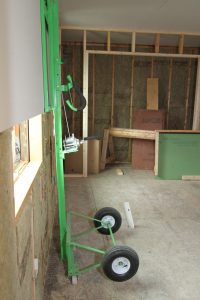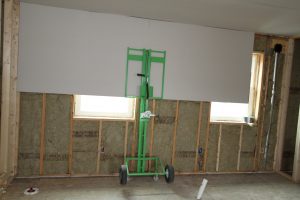HANGING DRYWALL ON WALLS
HangPro Drywall Lift TM
By Myron Ferguson
Today there are many new innovative products that come into the market. We often take a quick look and pass it by thinking, I really do not need that since I have been doing the task with no problems for years. Thinking of changing or trying something new can be tough for many reasons. I am glad I gave The HangPro Drywall Lift a second look. It is not an improvement of a drywall lift for ceilings. It is a completely different tool made for hanging drywall on walls. It does not work for hanging ceilings.
I work alone or with a small crew a lot so this is a tool I was looking for. The average home for example has over 3 times the sq footage of drywall needed to be hung on walls compared to ceilings. Half of the drywall on walls is the top sheet that has to be lifted up the wall and fit tight against the ceiling. NOTE: in many instances the HangPro Drywall lift can also be used to position and lift the bottom sheet of drywall.

I believe a new product should fill a need . I read a review years back about a battery powered caulk gun. The reviewer said “Why? Because you Can? Because it will be cool to have one?” Personally I have worn out at least three battery powered caulk guns. I apply a lot of drywall adhesive and squeezing out tube after tube of the adhesive can really strain your hands so the battery power really filled a need. The old hand operated caulk guns did the job but are very tiring to use. The battery powered caulk guns found a market for people who applied a lot of construction adhesive making the task easier and more productive.
I don’t really recommend hanging drywall alone but a lot of people including myself have been doing just that. It is very strenuous not too mention dangerous work that really should not be attempted alone especially if hanging drywall over 8 feet long. So until now getting help to hold up one end of the panel was the only option. The HangPro Drywall Lift not only holds up the panel in place, it is also can be used to transport the panel to the wall being hung and then lifts the panel up to a ceiling up to 10 ft high. The motto of the HangPro Drywall Lift is : “Transport, Lift, and Hold”.
“I didn’t know I was looking for a battery powered caulk gun but I have been looking for a drywall lift make for hanging walls.”
If we were standing in a building with ceilings 9’ high or less and we were discussing hanging drywall I think most people would say that hanging drywall on ceilings is harder to do than hanging walls. I actually think that ceilings are easier or are at least not harder than hanging walls. The main reason is that I use a drywall ceiling lift to place the panels and hold them in place as I cut out for electrical boxes or other openings and as I install drywall screws. This same lift can be used to hang the upper panels on walls as well but it is quite cumbersome and time consuming to accomplish. I have only tried using my ceiling lift a few times to hang walls and have given up because it is not really a time saver or really any easier than lifting by hand.
I was talking to someone who said that they really hate hanging drywall because it is just so difficult. And I agree it can be difficult because the sheets are long, heavy, quite cumbersome, and prone to cracking. So this person shared an example of why he hates hanging drywall. ….He was working alone and had a ceiling to hang so a 2×4 was screwed just below the top of the wall along the ceiling edge where the drywall will butt to the wall. He then lifts the drywall up and climbs up a stepladder and somehow gets the end to fit above the 2×4 and while near exhaustion positions the long edge of the panel against the panel already installed. Now with one drywall screw balanced on the tip of the screwgun he tries to insert the first of many screws necessary before he can relax only to realize that the screwgun has come unplugged. I replied that if that was how drywall was hung I would hate it also. My suggestions were to get a lift, use a drywall bench instead of a stepladder, get some help, use a cordless collated screwgun, or maybe hire someone to do the hanging.
I am sure that this person had a similar story to tell about hanging drywall on walls. The panels have to be placed tight against the ceiling and into the abutting wall or against the previously hung panel. While holding up the panel forget about installing a screw along the top (ceiling) edge because it is out of reach. Also because electrical boxes are cut out after the drywall is tacked into place there are many studs where a screw can’t be installed until the box is cut out. Then what if the panel just doesn’t fit properly. It may be too long because you cut it too long or because one wall is out of plumb. Maybe the ceiling is just too out of whack for a tight enough fit. You now have to lower the panel make the adjustments and lift again. By now the panel is getting heavy, especially if you are working alone, so as you install a screw it drops slightly, (remove the screw and start over). Repeat this process for wall after wall and you will start to look forward to the next ceiling so you can start using the drywall lift again.
As mentioned earlier there are a lot of walls in a building and hanging drywall on walls is not really a one man job. The panel has to be carried into the room and positioned parallel to the wall. If a 12 ft panel is being attached to a 12 ft long wall when the panel is lifted toward the ceiling it is not easy to do even if you have two people because it binds easily if one end is slightly higher than the other. Next the panel has to be held tight to the ceiling and tight against at least one intersecting wall and multiple screws have to be installed before the panel will stay in place well enough to let go and start cutting out for boxes and windows or doors.
To solve this cumbersome task the HangPro Drywall Lift can be used as a drywall hand cart to bring the panel into position along the wall. It then lifts the panel up uniformly toward the ceiling. Slight adjustments to left or right are easy because of the roller wheels along the bottom of the lifts frame. These rollers do not pivot so they only allow the lift to move parallel to the wall. As the drywall is cranked toward the ceiling the lift leans toward the wall and the roller wheels locked position prevent the lift from sliding away from the wall. The cradle carries the drywall panel toward the ceiling as it rides along the main frame of the lift. When in the proper position the auto lock hand wench locks to hold the panel tight. The panel can now be tacked into position, the cradle lowered, and the lift removed so that cutouts can be made and the rest of the screws installed. You could lower the panel to make modifications for a better fit if necessary. The point is that the drywall is easy to load on the lift, easy to bring into position along the wall, easy to lift up to the ceiling, and can be attached all without any physical lifting and holding, and difficulty fastening and cutting out of openings.
I have purchased a variety of devices made to aid hanging drywall horizontal on walls. All required me to physically carry the panel into position along the wall. Then lifting the panel onto the supports and balancing the panel while trying to install the first drywall screws. This was not possible alone unless I used only 8 ft long or shorter panels. The HangPro Drywall Lift addresses all these problems. Wheel the lift up to the drywall leaning against a wall. Lift one end of the panel up a few inches and rock the panel onto the front lip of the cradle. Crank up a few inches and you are ready to roll the drywall into position. The lift and drywall can be wheeled through doorways because the front roller wheels allow the lift sideways movement.
Really, there is no lifting or carrying the drywall and no extreme physical exertion needed to hold the panell in place while trying to install screws.
Overall I have to say the Hangpro Drywall Lift is a well thought out tool. It virtually eliminates the physical lifting of drywall when hanging walls. It does everything but carry the drywall into the building.
The HangPro Drywall Lift ™has That Drywall Guys “Seal of Approval”
NOTE: About 5 years ago I purchased a HangPro Lift from the inventor. He had about 20 made and I was lucky enough to get to purchase one. The first time I used the lift I was so impressed that I wanted to tell someone (tell everyone) but I was working alone. I have since been involved in the transformation of this product and I am part owner of HTM Innovations LLC that will be launching the Hangpro Drywall Lift this fall(2018). For more information check out our website www.hangprolift.com to view video. I will be posting more information regarding the HangPro Drywall Lift in the coming months and in addition the website will be updated when the HangPro Drywall Lift is available.

This will help a lot can’t wait for it to be released
Use a drywall router with a drywall bit installed or a keyhole saw to neatly cut the hole for the outlet box. The drywall router is handy for larger jobs where there are numerous outlet holes, windows and doors to cut. Keyhole saws are great for smaller projects and hard to reach areas where there isn’t much material cut out.
Wow, I need one! I couldn’t tell you the amount of times that I have hung drywall by myself and let me tell you it takes a toll on my body and energy. Where can this be purchased?
Lots of places on line. Called the HangPro Drywall Lift for Walls http://www.hangprolift.com
There are obvious advantages to drywall over plaster. First, the process of installation requires less time and labor, which can translate to less cost. Drywall also helps to reduce noise along with having fire-resistant properties due to the water in the boards.
Drywall and the finishing process was developed to help speed up the construction process during the housing boom after World War 2. It was referred to as Drywall because compared to traditional plaster it is a much dryer process that can be decorated right after finishing. I think the modern day process of plaster which is applied over Blue Board is still pretty wet but not as bad as in the past.
It’s funny that you mention sound control. The new lightweight drywall is less dense so I believe it is not as good for sound control as the old heavier stuff.